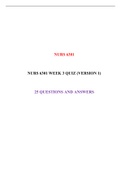Samenvatting
Strategy Implementation - summary of the lectures and all articles - by Michel Dagli
- Instelling
- Tilburg University (UVT)
All in one summary - this is a comprehensive summary of lectures and articles. Articles and lessons are in the correct order. See the table of contents for more info.
[Meer zien]













